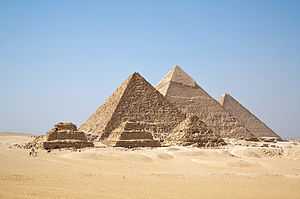Middle Egyptian language
| Middle Egyptian | |
|---|---|
| Region | Ancient Egypt |
| Era | ca. 2000 to 1350 BC, when it evolved into Late Egyptian |
|
Afro-Asiatic
| |
Early forms |
Archaic Egyptian[1]
|
| Language codes | |
| ISO 639-3 | – |
| Glottolog | None |
Middle Egyptian is the typical form of Egyptian written from 2000 BC to 1300 BC (after Old Egyptian and before Late Egyptian). In writing, it makes use of around 900 hieroglyphs. Ancient Egyptian history covers a continuous period of over three thousand years.
Eventually evolving into Late Egyptian language in 14th century BC,the Middle Egyptian language remained in use as literary standard language until the 4th century AD. As such, it is the classical variant of Egyptian that historically attracted most attention from Egyptology. Whilst most Middle Egyptian is seen written on monuments by Hieroglyphs, it is also written using a cursive variant, and the related Hieratic. As it is usually the first and most used form of the Ancient Egyptian language, it is frequently (incorrectly) referred to simply as "Hieroglyphics".
Due to archeological findings which showed where Mesopotamia started to influence the language of the Egyptians. This is due to the ivory tags discovered at Abydos which also documented the quantity and geographic origin of such records. Up until today, thanks to Archeologist findings and translators, 70 percent of these hieroglyphs have been translated, with still much more to decode. Many other archeological findings suggest that Mesopotamian language was based on Egyptian culture and not the other way around because the Mesopotamian state administration required that the names of the individuals be entered on the accounting tables. This was extremely similar to what the Egyptians did, which they were doing years before that, showing the cross cultural interaction that was happening between the two cultures.
Middle Egyptian writing was composed entirely of pictures, just as it was in the old and new. There was some influences on the change from the Mesopotamian culture, as well as the Sumerians. It wasn't until the Egyptians converted to Christianity,in which they started to stop using their own writing. Which eventually converted to the Greek alphabet then eventually retiring ending in the Coptic language.
Egyptian culture declined and disappeared nearly two thousand years ago. It was not until Napoleon’s invasion of Egypt in 1798 that the artifacts of the Egyptians were seen in Europe and their ancient culture began to be recognized again. This was only the beginning to the findings of the early, middle, and new languages of classical Egyptian period. Although Middle Egyptian became the literary and written language, the spoken language continued to change throughout following years.
Progress in the understanding of Middle Egyptian is due to Adolf Erman and his "Berlin school". Erman also published the first Middle Egyptian grammar in 1894, surpassed in 1927 by Alan H. Gardiner's monumental work. From the mid 20th century, Egyptologists considered their understanding of Middle Egyptian to be essentially complete, and began focusing on Old Egyptian, but debate on Middle Egyptian grammar was revived by Hans Jakob Polotsky and his "standard theory" from 1944.
References
- ↑ Middle Egyptian does not derive from Old Egyptian, which was based on a different dialect.
Literature
- James P. Allen: Middle Egyptian: An Introduction to the Language and Culture of Hieroglyphs. Cambridge: Cambridge Univ. Press, 2000.
- A. H. Gardiner: Egyptian Grammar, Oxford, 1927, 3rd ed. 1957.
- Teeter, E. "The Egyptian Language and Its Scripts." Calliope 14.9 (2004): 10-10.
- Middleton, A. "The geology of the Rosetta Stone." The Journal of Egyptian archaeology 89 (2003): 207-216.
| ||||||||||||||||||||||
